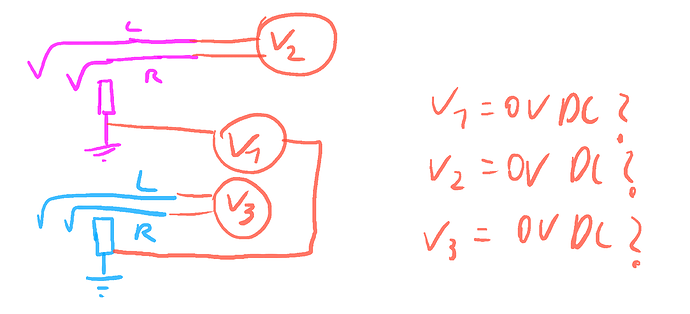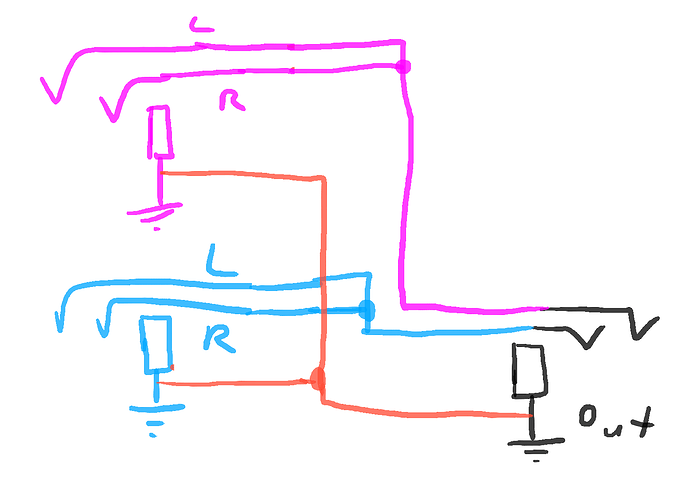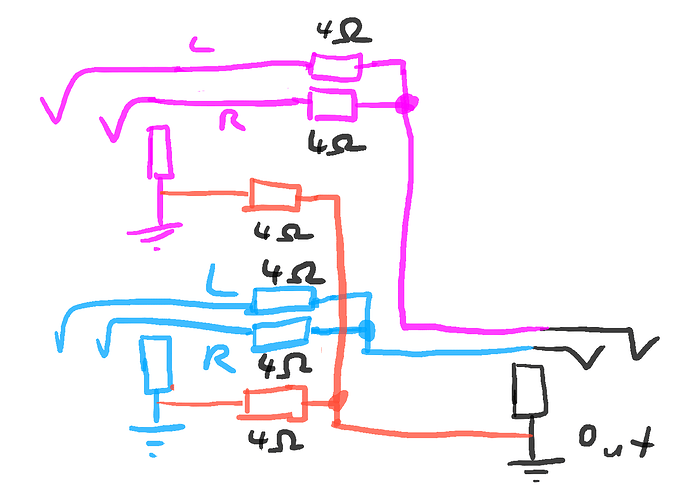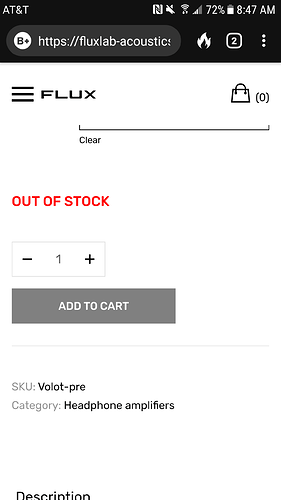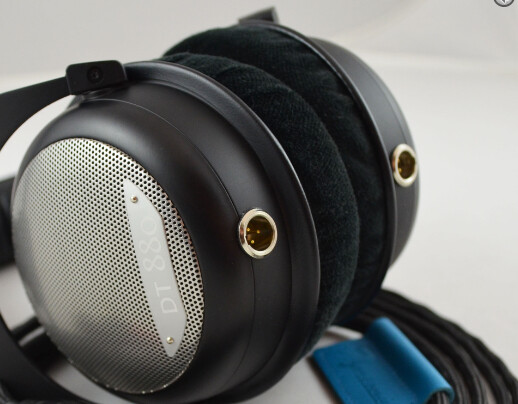I want to find an open back headphone of high sound quality that uses a 2.5 or 3.5 TRS input on each ear cup. Reason being I want both of my Singxer SA1 amps, one getting left signal only into both inputs, & the other getting only right signal to both inputs, so they each can run full power to each side of the headphones via their respective 1/4" TRS outputs.
The idea is flawed and you need to give up on it. You can’t use all the power of the SA-1 in a single channel and you can’t merge them and still use them on a single side of a headphone. Get monoblocks or give up. I could be wrong, but I don’t think the 3.5mm inputs on headphones actually use all of the TRS pins, I think its just using TS, but there could be outliers I guess. There’s really only like 2 or 3 headphones out there that would actually benefit from the gobs of power you’re trying to put into them. And from a conceptual standpoint, the SA-1 isn’t nearly well controlled or detailed enough to even care about wanting 2 as monoblocks, IMO. You could save a lot of money just getting a good amp instead of 2 mediocre ones.
My ears say different. The SA1 is also a spectacular preamp for my speaker system, running them dual mono. At a later date I am thinking Orchard Audio Starkrimpsons. Right now they feed my Avantone CLA200 & sound amazimg on my Tannoy XT8F towers.
On another note my Tannoy Definition Sub did not show up as scheduled today. Yuge sale from Upscale Audio.
My main point was for the price of 2 SA-1s, which is $1200, you can get a significantly better amp than them. Overall quality will be significantly higher than the SA-1, and likely a better preamp as well. I can’t stress how much better amps get over the SA-1, and it’s not a small gap. Just my opinion on the whole thing, especially since you still aren’t going to ever be able to use both channels into one side of a headphone with anything but problems, but the main point is that even if you could (and you can’t) you are still going to run into time sync problems and aren’t even going to use the power unless you max the volume and control it with a DAC or preamp, which could work for the volume control, but isn’t going to remedy the problem of the SA-1 not being able to sustain any amount of load as well as just attenuating the volume with the amp. The reason you’re wanting more out of the amp is because the amp itself lacks capability, not because it’s the best and you need to run 2 of them.
Check for DC-offset between the grounds of both amps. Ideally, it should be 0V, but reality is often disappointing.
Assuming all offset-voltages are the same (0V DC between Left and Right output on both amps), you have to make that adapter yourself.
Grouping Tip and Ring from each amp together to be Tip and Ring in the headphone plug.
On a headphone wired for balanced, this gets a bit less iffy since the grounds of the amps are seperate.
 Caution!
Caution!
-
Using amps that are not meant for bridge in a bridged setup can damage them!
-
Be aware that Signal Ground and Case/Chassis Ground may not be the same (= floating). When running both single ended outputs into each other, enormous currents may flow damaging both amps.
It’s an experiment certainly. I might not ever complete it. I’m very pleased with the results thus far. I know now it would be better with 3 identical amps so I wouldn’t need to plug & unplug anything to get a direct comparison between single stereo & dual mono.
I have encountered 2 errors, both related to my speaker amp & speakers. The first was I forgot my speaker amp was on when I began the experiment & it was directly connected to my DAC when I unplugged the balanced output. The second was I forgot the speaker amp was on when I was toggling the preamps off of HPA to change the headphone cables, but still had music playing & the volume set for 600ohm DT880s. Z mentioned this design flaw in his review of the preamp. Both incidents were very startling, but luckily no apparent damage done.
The 2 guys that own this website both love the Singxer SA1 by the way.
I will put some thought into a save-ish way to do what you are looking to achieve here.
Might be worth sending an email to Singxer for some pointers too, or via ASR which one of their engineers participates there (under the handle tom.chen).
There is also an option to run the balanced outputs of the amps, 4.4, or 4 pin XLR, with a custom cable termination to TRS or mini XLR into the earcups that take those terminations. Technically this would keep the signal output balanced. In any case, balanced or not, each amp will only see the ohm load of a single driver. If its above 32ohms it should be fine I would think. Of course 150-300ohms might be more ideal.
Okay, some back-of-napkin thoughts:
The easiest is putting Stereo-to-Mono and mono-Y-splitters behind the amps.
Now the harder part:
This is an important check! There may be DC-Offsets ranging somewhere between a few mV up to single digit Volts between devices or channels. Offset voltage divided by output impedance should give a ball park figure of power lost to the amp fighting itself (or its neighbour).
The basic dangerzone setup:
![]() I STRONGLY advise against doing it this way!
I STRONGLY advise against doing it this way!
To lower the risk of magic smoke release, I propose using some 4 Ω resistors (≥ 1W each) in all potential current paths:
This way, the lowest impedance the amps should ever see is 8 Ω (ignoring LCR-properties of the resistors used). Putting a “mute switch” in the pink and blue paths leading to the out jack to temporarily disconnect both amps during plug insertion is also advised.
Imaginary Q&A:
“My multimeter says 0” - Is it a hardware-store-check-out-special? Because it may be off by a couple percent and some counts.
“I volume match with my multimeter” - What frequency range does it cover and is it true RMS?
“But my Dollarstore meter…” - “NO! It is NOT accurate!”
I don’t really understand any of that. I’m not an electronics engineer. I just know outputs to inputs, red to red, white to white.
Instead of buying parts & building line level high pass boxes with a subwoofer bypass output, I just bought a Tannoy Definition Subwoofer that has balanced XLR high pass built in.
But you do realize that what you want Is not just simple signal input / output or red to red and white to white? You really should stop before something bad happens.
If you need more power, just buy a more powerful headphone amp. Keep it simple and in the Red Red - White White levels.
1 x Preamp → 1 x AMP and that’s it.
E: Or maybe buy a VOLOT Dual Mono Class-A Headphone Amplifier with Pre-Amp?
This probably does everything you would need right only in single device?
I would describe myself as an “ambitious hobbyist”.
Thing is, doing “red to red” as you say, may result in two dead.
This.
Setting up what you are after is probably feasible, requires some careful planning and testing before hand though.
I know. Thinking it out, all I need to figure out is, are there quality headphones that use a balanced TRS or mini XLR input in each cup? Then all I need are 2 custom cables. Hello Hart Audio. The amps will not know they’re not pushing a stereo signal, particularly if the ohm load of the respective driver is equal to or higher than 32ohms. Balanced will be the way to go I’m sure.
Currently the single ended sounds exceptional. Granted, half of each amp is idle. Last night my S599SE sounded very muffled after listening to 600 ohm DT880 & 250ohm DT1990 Pro. Tonight as the 599s were already plugged in, they sound fantastic. Listening to Essential Billy Joel, & Chicago 17.
I mean it was just one option.
Bryston BHA-1 probably does the same. orderable atleast from 3 different stores = in stock.
Has a Balanced XLR Pair (3 Pin Left/Right)
So there probably are even more options than these 2 if you just search for them.
But since you have the amps. Lets focus on headphones.
Yes!
Pick a pair of quality headphones and then just add little DIY on top. ![]()
![]()
Red to red and white to white and black to black. Things you do know.
Like in here, someone did.
But for this project probably Audeze would have good options as well since they have 4-pin XLR’s on both cups. Probably just a red-red and white-white thing after all. Who knows.
![]()
Keep us posted how the project continues.
I’m almost 100% sure only 2 of those pins are used per side. Having rewired a couple pairs of 600ohm beyers myself to a single 4 pin mini-XLR, there was only 4 wires, 2 for each side. I think only 2 pins are used on each side of the Audeze plugs as well.
I come from a musician’s background pertaining to audio electronics, so I know what cable goes where & why. XLR for microphones, TRS for DI outputs that may have a hiZ/SE/TS input/electronic keyboard outputs/electronic drum outputs; of which all plug into the mix console preamps. A DI can be used for any electronic instrument that doesn’t have a balanced output. Often bass guitars will use a DI. The PA amps used either TRS or TS as speaker wires to the PA speakers. I forget which.
I have some experience in car audio also. I know each speaker has a +/positive/hot & a -/negative/ground connection, but that’s about it.
I know most amplifiers increase power as the ohm load lowers & some amps double power as the ohm load halves. Those tend to be expensive. I’ve never owned an amp that can double power output from 8ohms to 4ohms & so on. Some amps are a total mystery to me. Those amps that cut power as the ohm load lowers. Whats even more weird is they tend to cost a lot more.
I had a point. Where am I? Oh, I’m not a DIY person. I have an understanding of some things. That’s about it.
If a headphone is really balanced I would think it must have either a 3 pin XLR per side, or TRS, as a balanced connection requires a positive, a negative, & a neutral ground, hence the 3 pins of XLR & the Tip/Ring/Sleeve of TRS? Therefore 4 pin stereo XLR can’t really be balanced can it?
Lots of life getting in the way. No further developments as yet. I’m about to go ride my motorcycle.
I do have an observation. My DT150 have a 6 pin connection. This would indicate that they are truely balanced IMO, but they only have a TRS termination. Sucks. I’m waiting on a cable. They shipped without one, or it was lost in trasit.
For Sure.
But if you are connecting two balanced amps in one headphone per two cups.
How many wires you would need, using a XLR connectors? ![]()
Im just curious how the project ends now and not the answer (MazeFrame answer above)
